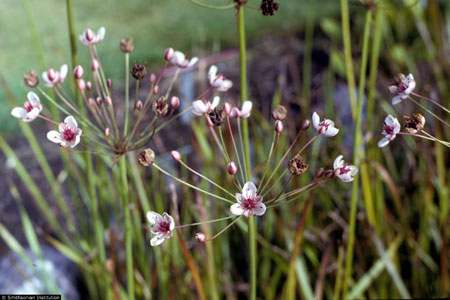
INVASIVE SPECIES | FLOWERING RUSH
Flowering rush has invaded the shores of Michigan waterways since the early 1900’s, affecting the Detroit River as early as 1918, but in recent years has become a much greater problem, and is listed as a restricted noxious weed by the U.S. Department of Agriculture. However, flowering rush is a popular and common plant for water gardens, which can be easily obtained through the horticulture trade, making it difficult to stop the spreading.

The photo is courtesy of the Smithsonian Institution
With flowering rush’s ability to grow in shallow, slow moving ditches, streams, rivers, and lakeshores in temperate regions, it makes the Great Lakes Region susceptible to flowering rush’s potentially harmful effects. Since flowering rush’s rhizomes (the horizontal root-like stems) are fleshy and thick and produce bulbils (small bulb-like structures at the base that can produce a new plant), our lakeshores and riverbanks are exposed to potential threats of impeded irrigation, the promotion of deposition of sediment, negative impacts for recreational activity, decreases in open spawning habitat and decreases in abundance and diversity of native plant species.
In 2007, a study of exotic and invasive species in Great Lakes coastal wetlands found flowering rush along Lake Erie and Lake Ontario shores but not in the other three lakes (Trebitz and Taylor 2007). However with reports of flowering rush in out-of-state waterbodies such as the Elkhart River in Indiana and Oconto River in Wisconsin, concern grows for those other three lakes. The Elkhart River is a tributary of the St. Joseph River that flows through Michigan and discharges into Lake Michigan. Populations in the Elkhart have been present since 1952 and since 1991 in the Oconto River.
Since flowering rush is difficult to remove entirely once it’s been established, the best method of management for flowering rush is prevention. Being a restricted species in Michigan, flowering rush may not be sold or grown without a permit in the state, which helps restrict human distribution of flowering rush. Other methods to reduce its dispersal and impacts include: washing boating and fishing equipment and removing plant matter before transporting between locations, and disposing of the plant fragments so that it does not runoff back into the lake or stream.
As a lover of the Great Lakes and any body of water, I hate to see potential threats that could harm our wildlife and destroy native habitats. So keep your eyes open for flowering rush, which produces pinkish/purplish flowers from June to August. Summer months are the best time for detection when you’re out at the beach or trolling along the river. As a citizen it’s our duty to help keep the Great Lakes Great!
This article is part of the ongoing series on invasive species funded in part with funds from the Michigan Invasive Species Grant Program through the Departments of Natural Resources, Environmental Quality, and Agriculture and Rural Development
